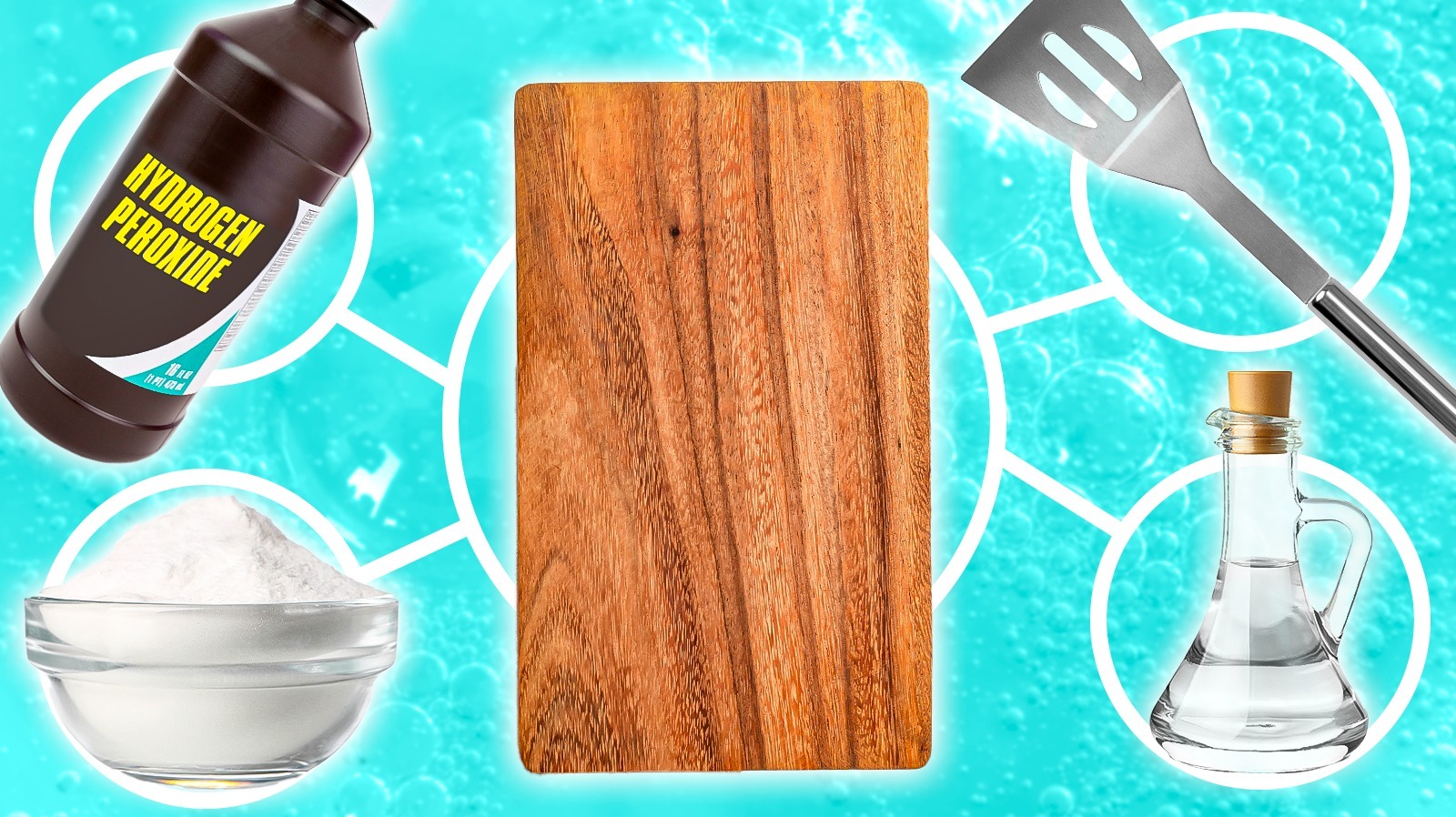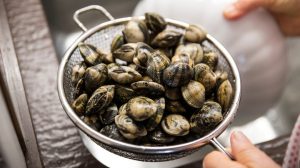Most cooks are diligent about keeping counters, knives, and other silverware they use to cook food clean, especially when dealing with potential contamination sources like raw chicken. However, keeping cutting boards clean is equally, if not even more, important. Bacteria and other potentially dangerous particles can easily become trapped in the nicks and grooves in cutting boards over time, eventually multiplying and affecting not only the board but the food you end up preparing on that surface.
A simple rinse in the sink often isn’t enough to fully decontaminate these boards. So how should you keep your cutting boards clean? There are quite a few ways, and they may change slightly depending on if your cutting boards are plastic or wooden, and also on what home cleaning tools you have on hand. Through our own extensive experience and research, the following list should help answer all your questions, as well as why your preferred method so far may not be the best, and why your boards may seem dry or cracked.
Use a metal spatula for food stuck on boards
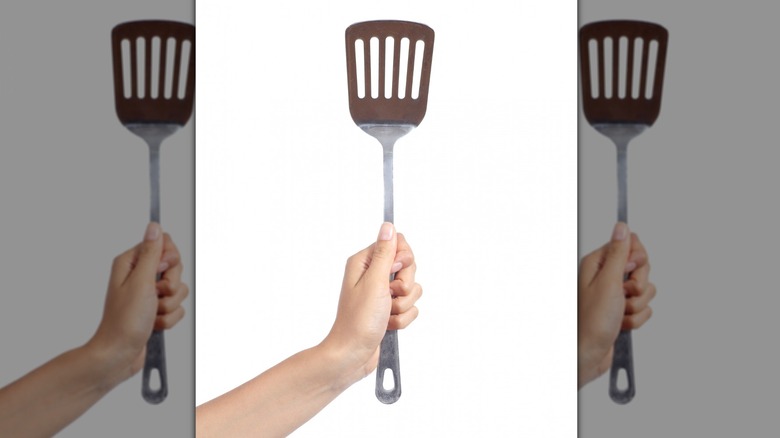
Have a metal spatula on hand, or another equivalent tool, to remove larger food particles stuck onto the board before undertaking any daily or deep cleaning. You can also use this spatula, or something like a bench scraper, to remove any stuck-on coarse salt you have used for cleaning (more details on this below).
If you skip this step, disinfecting and cleaning your kitchen cutting boards, whether they are wooden or plastic, won’t be as effective. The solutions you choose to use won’t permeate down to the actual material of the board, and it’s likely that food particles and other possible sources of contamination will be left behind.
Try to scrape off any gunk on the board as carefully as possible to avoid excessively scratching up the surface, as this will wear out the material faster over time. Though some scratches are expected, you don’t want to cause more damage than is absolutely necessary while cleaning the board.
Distilled white vinegar
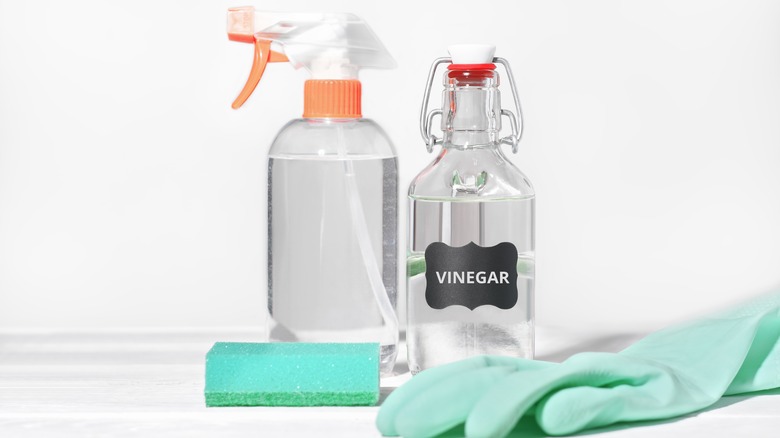
Unsurprisingly, one of the best homemade cleaning solutions for almost any stain or mess in the kitchen is also useful when it comes to cleaning cutting boards. Use a bottle of distilled white vinegar to neutralize bacteria and avoid potential contamination of future foods you prepare on the cutting board.
This step is necessary if you have just prepared raw meat on your board, especially a bacteria-causing food source like chicken, which can carry salmonella. For optimal results, mix one part vinegar with four parts water in a bottle or bowl. Another option is to put the solution in a spray bottle.
In order to disinfect your board, soak a clean, dry cloth or sponge in the white vinegar solution and scrub the board carefully and thoroughly before washing it in the sink. If you used a spray bottle, instead, spray the cutting board, ensuring that you cover the entire surface, front and back. Let this solution soak into the board for a few minutes before wiping it down with a cloth. In either case, you will want to rinse off as much of the vinegar as possible before drying the board so the somewhat overpowering taste and smell of the vinegar don’t transfer onto other foods. Many cooks prefer using white vinegar to other alternatives because it is natural and non-toxic, unlike some other cleaning solutions.
Hydrogen peroxide
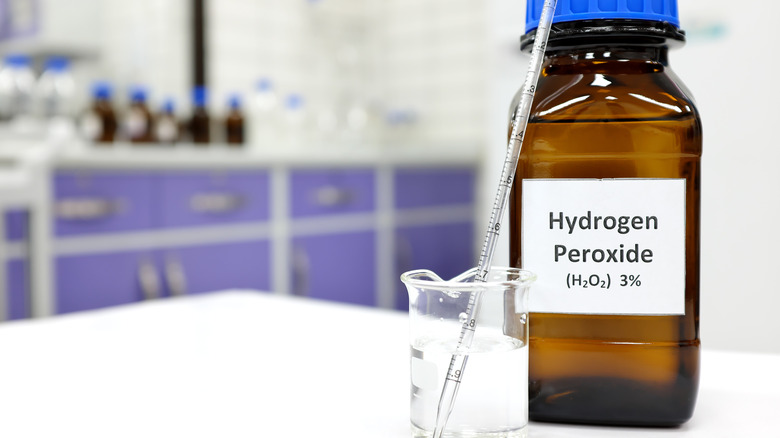
For cooks who want to make extra sure that any possible sources of contamination are eradicated, hydrogen peroxide is the way to go. The reason this substance works is because it’s a combination of water with an extra oxygen molecule, and when it comes into contact with a surface, the extra molecule oxidizes, killing germs in the process.
For optimal results, use a 3% hydrogen peroxide solution and pour it all over the board, making sure the entire surface is covered. Some people may think “food-grade” peroxide with a concentration of 35% is better, but that’s generally only used in industrial and commercial kitchens because it has to be handled very carefully, as the fumes can be toxic. It’s also unnecessary for simple home kitchen cleaning.
When you pour the solution, don’t be concerned if it makes a fizzing or sizzling sound, that means it’s working as expected. After a few minutes, wipe the hydrogen peroxide off with a clean sponge, and rinse it out thoroughly to make sure none of the solution remains on the board and transfers to other food you prepare there. Also, wash and rinse out the sponge thoroughly if you’re going to use it again. Though you can use hydrogen peroxide for any kind of cutting board, it is especially effective when used on wooden cutting boards, as it is with most wooden kitchen utensils.
Baking soda or coarse salt works on enduring stains
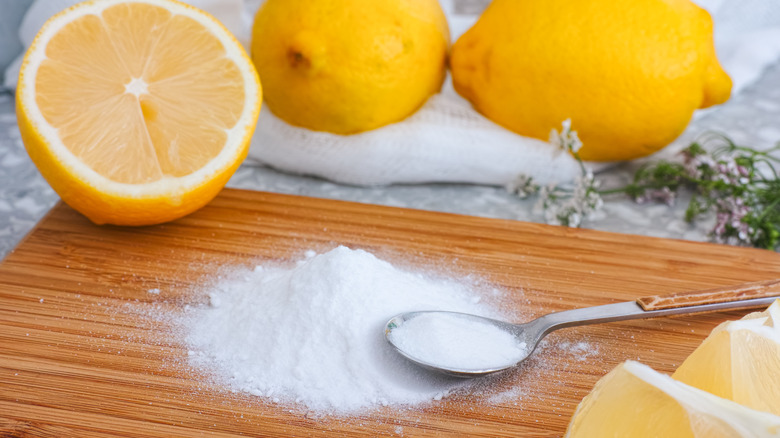
Ekaterina79/Getty Images
Sometimes, no matter how much you scrub and rinse a cutting board, it will sometimes get stains that refuse to go away, especially with brightly colored, juicy ingredients. Though these might not actually pose a health hazard as long as you clean your board well enough, they can still be an eyesore. However, there is a surefire way to take care of them.
To remove stains, sprinkle some baking soda or coarse salt over the surface of a completely dry board and let it sit for a few minutes. Then, take a sponge or cloth dipped in hot water — it’s important that the water is above room temperature for optimal stain removal — and scrub the soda or salt over the surface of the board. This primarily works because the coarse texture of the grains on the wood is abrasive, and thus helps remove surface stains by essentially gently sanding down the top of the board.
If you have a plastic cutting board, don’t worry, as this method also works on plastic. At the end, rinse off the cutting board and towel it dry before letting it fully air dry on a rack.
Choose a fresh lemon for scent removal
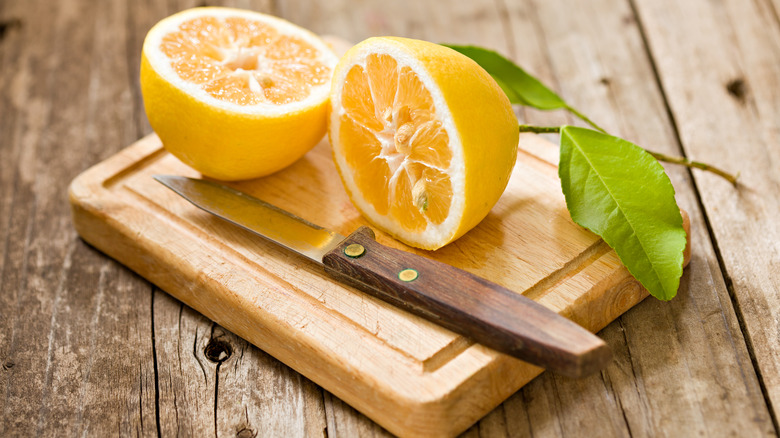
Sometimes, in addition to stains, odors from more aromatic foods can become deeply ingrained in a cutting board, especially in a porous material like wood. In order to remove both odors and stains or add a little more abrasiveness to the previous baking soda method, use a halved fresh lemon instead of a sponge or cloth to wipe off the baking soda.
Using a lemon minimizes smells from previous food, like onion and garlic, that can transfer onto the next ingredients you prepare on the board. This is especially useful if you’re preparing a new meal for guests who can’t stand particularly pungent smells or tastes, or if you simply don’t want to be transferring previous flavors into the foods you are preparing and mess up the taste balance of a dish.
The lemon works particularly well as citrus scents tend to neutralize most scents, especially alkaline odors, and the lemon can also help break down food residue you can’t see with the naked eye. This fruit also works for stains because the acidity of the lemon adds another abrasive element in addition to the baking soda or salt, that helps scrub down the board.
Never use dishwashers for wooden boards, and clean both sides
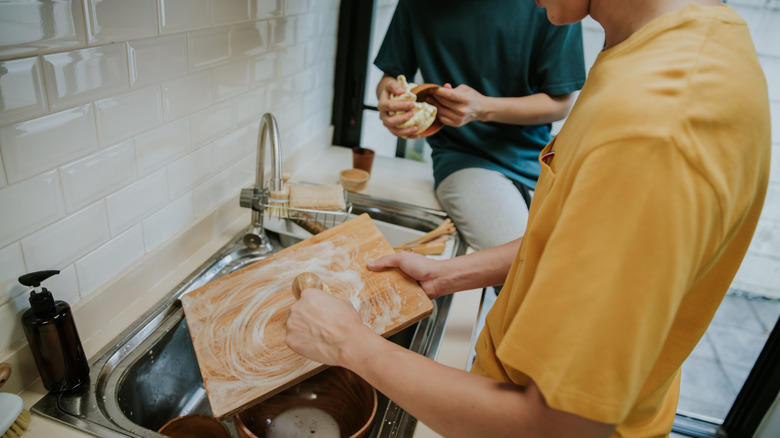
A lot of wooden cutting boards aren’t made to handle the powerful cleaning of a dishwasher, and can easily crack and warp. When this happens, it creates more opportunities for bacteria to infect these cracks and potentially contaminate other foods you prepare.
Instead of running your wooden cutting board through the dishwasher, carefully and thoroughly clean both sides with dish soap and scrub, whether it’s a textured sponge or metal wool. A lot of people decide to take the shortcut of only cleaning the side of the board food was prepared on. However, since juices and other food particles can easily drip onto the other side, it’s always recommended that you thoroughly wash both sides of the board. If there are any existing scratches, spend a little more time washing and scrubbing that area.
After you’re done, rinse both sides with warm water. Lastly, take a clean cloth or paper towel and dry the board, leaving it to air dry on a rack after the process is completed.
Oil or use beeswax on wooden cutting boards once a month
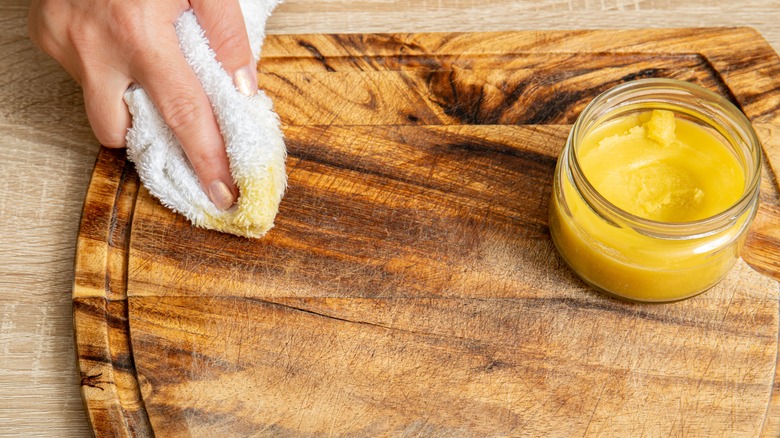
Wooden boards are susceptible to cracking and drying out over time and repeated use. Oiling them about once a month helps avoid this damage, and also creates a water-repelling layer on the wood that helps prevent liquid contamination and stains.
You can’t use just any old cooking oil however; rubbing food-grade mineral oil into the board is one of the best options. The oil has to be safe when coming into contact with food, and cooking oil will likely soak into the wood and leave scents and residue of the oil’s flavor. Food-safe mineral oil generally tends to be both flavorless and odorless, which is optimal for leaving your board unstained with unwanted odors and residue.
Another alternative is beeswax. The wax creates a protective layer over the wood, much like a food-grade mineral oil, and makes it look newer and shinier than it did before. In a more practical sense, it will also impart moisture into the wood, protecting against future breakage and cracking.
Use steel scouring pad on plastic cutting boards
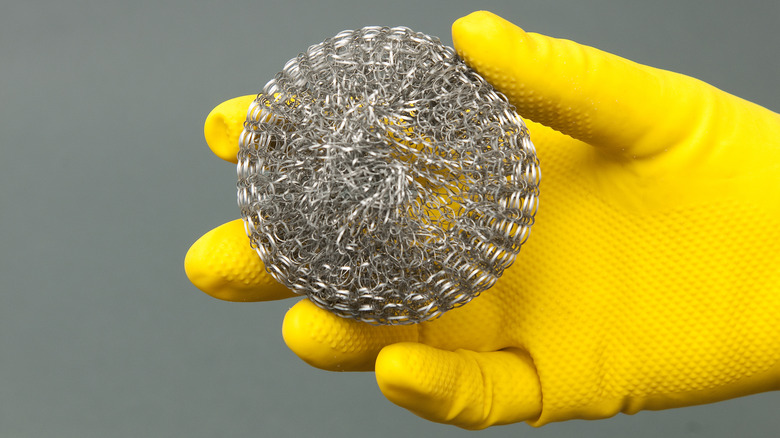
Plastic cutting boards have the advantage of being dishwasher-safe but are also very susceptible to scoring and nicks on the board’s surface. If you start noticing a lot of scoring, use a steel scouring pad on the board to get rid of any loose plastic particles that can make their way into your food.
This recommendation comes with a caveat, as steel wool is generally not recommended for wooden cutting boards since it can create more damage to that material. However, if you use a plastic cutting board, you may want to use steel wool to remove larger ridges, nicks, and generally visible plastic particles poking out of the board. If you want to do an even more thorough job, you can then follow up with sandpaper to get the board nice and smooth. This will not only help prevent decontamination but also make the board look more visually appealing and make it an easier surface to use a knife on and on which to prepare food.
Replace plastic and wooden cutting boards every year or two
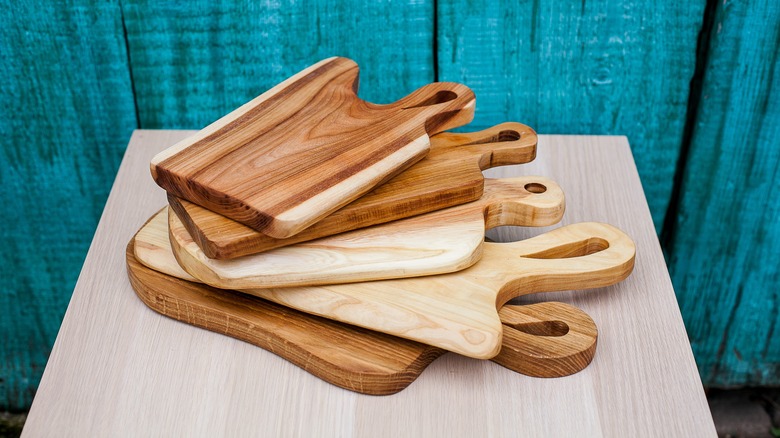
Most people don’t replace their cutting boards nearly as often as they should. No matter how well you clean cutting boards, whether they are plastic or wooden, it’s a good idea to replace them every year if you use them frequently, and every two years if you use them less often. If you maintain wooden boards properly, they generally have a longer shelf life than plastic cutting boards.
Boards that aren’t replaced start to get very damaged, lose their shape, and become less safe in terms of sanitation, as well as harder surfaces on which to actually prepare ingredients. If you’ve made the mistake of running your wooden board through the dishwasher, warping and cracking may be showing up on the board earlier than expected.
If you prepare a lot of meat in your kitchen, or other animal products that may be carrying bacteria, it’s a good idea to buy a plastic cutting board as a replacement instead of a wooden board. You can also combine both, and use the wooden board for produce while using the plastic board for anything that may risk contamination.
Properly dry your boards
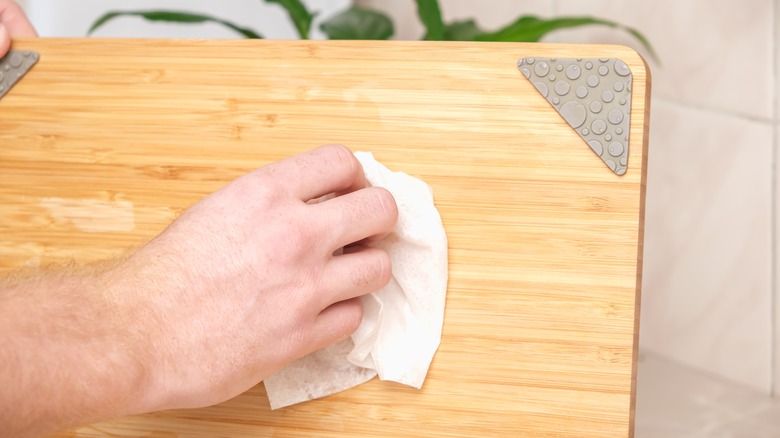
Getting your cutting boards clean isn’t just about washing them properly, but also about drying them properly. For wooden and bamboo cutting boards, dry them off with a dishcloth, and then make sure you set them up vertically on both sides so that they can finish air drying well. The vertical position is meant to ensure even drying, as if you place a slightly moist surface of a cutting board on another surface, the liquid will be trapped in that space and won’t evaporate easily.
If you don’t dry your boards properly, your cutting board may end up retaining moisture or the remnants of any solutions you used — such as hydrogen peroxide or vinegar — which will result in possible contamination of future foods, as well as potential shrinkage, warping, and cracking of your board. In addition, the best way to work on cutting boards is to make sure they are incredibly dry, so your ingredients don’t stick on the surface and make your job of chopping or mincing much more difficult.



